| | Manure incorporation requirements | Soil nitrogen and salinity limits | Nutrient management plans | Manure handling plans | Record keeping and soil testing | Compliance and enforcement process | Minimum setback distances for manure application | Minimum setback distance to a residence or occupied buildings | Minimum setback distances for application on forage, direct-seeded crops, frozen or snow-covered land | Determining slope | Common body of water
The purpose of AOPA is to ensure that the province’s livestock industry can grow to meet the opportunities presented by local and world markets in an environmentally sustainable manner.
The Agricultural Operation Practices Act (AOPA) includes regulations for spreading manure or compost for all livestock operations in Alberta. The manure spreading regulations include requirements for manure incorporation, soil nitrogen and salinity limits, setback distances, record keeping and soil testing.
The term manure in this publication includes the livestock excreta, straw, other bedding material, litter, soil, wash water and feed in the manure. Composted manure has the same requirements as manure. Terms used in this publication have been simplified to make it easier to read. Complete definitions are found in Section 1 of the legislation.
For more information on the regulations, please refer to the contacts listed at the end of this publication.
Manure Incorporation Requirements
Manure must be incorporated within 48 hours when applied to cultivated land (except when applied to forages or direct-seeded crops, frozen or snow-covered land or unless an operation has a permit that specifies a different incorporation requirement). Additional requirements related to manure incorporation are outlined in the sections on setback distances in this publication.
Soil Nitrogen and Salinity Limits
The regulation sets soil nitrate-nitrogen and salinity limits. It should be noted that these limits can only be exceeded if a producer has a nutrient management plan that has been approved by the Natural Resources Conservation Board (NRCB).
To ensure the salts in manure do not affect plant growth, the regulations specify that manure must not be applied to soils that have an electrical conductivity (salinity) greater than 4 deciSiemen per metre (dS/m) from the top 0 to 15 cm of the soil. Manure should not be applied at levels that may increase the soil salinity (after manure is applied) by more than 1 dS/ m from a soil depth of 0 to 15 cm.
The soil nitrate-nitrogen limits are set according to various farming methods, soil groups, soil textures and the depth to the water table.
The following table specifies the nitrate-nitrogen levels that may not be exceeded in the top 60 cm of soil after manure application.
Nitrate-nitrogen limits in soil (Standards and Administration Regulation, Schedule 3, Table 3)
Farming
method | Soil group | Sandy (>45% sand and water table <4 m) | Sandy (>45% sand and water table >4 m) | Medium and fine textured soils |
 | Brown | 80 kg/ha (75 lb/ac) | 110 kg/ha (100 lb/ac) | 140 kg/ha (125 lb/ac) |
| Dryland | Dark Brown | 110 kg/ha (100 lb/ac) | 140 kg/ha (125 lb/ac) | 170 kg/ha (150 lb/ac) |
 | Black | 140 kg/ha (125 lb/ac) | 170 kg/ha (150 lb/ac) | 225 kg/ha (200 lb/ac) |
 | Grey Wooded | 110 kg/ha (100 lb/ac) | 140 kg/ha (125 lb/ac) | 170 kg/ha (150 lb/ac) |
| Irrigated | All groups | 180 kg/ha (160 lb/ac) | 225 kg/ha (200 lb/ac) | 270 kg/ha (240 lb/ac) |
Note: To convert kg/ha into lbs/ac, divide by 1.1 (eg. 110 kg/ha / 1.1 = 100 lbs/ac)
Nutrient Management Plans
Nutrient management plans are not mandatory for every person who applies manure. Under AOPA, an approved nutrient management plan is required if a person wants to exceed the soil nitrate-nitrogen or salinity limits when applying manure. The NRCB can approve a nutrient management plan for applying manure in excess of the limits if the NRCB is satisfied that implementing the plan will not adversely affect the soil or the environment.
Manure Handling Plans
A person applying for a CFO permit can submit a manure handling plan to the NRCB for approval to reduce or eliminate the need to meet the manure application and storage requirements under AOPA. The NRCB may approve a manure handling plan that provides an alternative to complying with the manure application and storage requirements. For example, an operation may submit a manure handling plan where an agreement is in place with others who will be accepting the manure from the operation. Manure production and transfer records must also be kept in these situations.
Record Keeping and Soil Testing
Each person who handles 500 tonnes or more per year of manure must keep manure management records for five years and must also conduct soil tests on the land where the manure is applied. The manure must also be applied according to the soil nitrogen and salinity limits in the legislation or an NRCB approved nutrient management plan. The soil test results for land on which manure is applied must not be older than three years except for soil texture, which is a one-time analysis. The record keeping requirements do not apply to manure produced by livestock when they are grazing. Further details and examples of record keeping forms are available from the contacts listed at the end of this publication.
Records required:
- soil test results
- amount of manure produced or handled
- name and address of each person who receives or applies manure as well as applicable dates
- land location where manure is applied
- application rates of manure and fertilizer
Compliance and Enforcement Process
The NRCB is responsible for administering the legislation. An inspection by the NRCB can be triggered if the NRCB receives a complaint. NRCB inspectors typically look at potential risks to the environment or problems related to manure handling, storage and application. If a problem is found, inspectors will work with operators to resolve the situation. When determining the appropriate enforcement response, inspectors will consider the significance of any non-compliance as well as the risk to the environment and the operator’s willingness to address the issue voluntarily.
Minimum Setback Distances for Manure Application
Setback distances are required to reduce nuisance effects on neighbors and to minimize the risk of manure leaving the land on which it is applied and entering a common body of water. Manure must be applied at least:
- 150 m away from a residence or other occupied building that the operator does not own if the manure will not be incorporated when spreading on forage or direct-seeded crops
- 30 m away from a water well
- 10 m away from a common body of water if subsurface injection is used
- 30 m away from a common body of water if manure is surface-applied
- and incorporated within 48 hours of application, except when applied on forage, direct-seeded crops, frozen or snow-covered land.
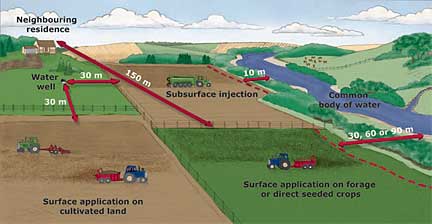
Minimum Setback Distance to a Residence or Occupied Buildings
If manure is spread on cultivated land and is incorporated within 48 hours of spreading, no setbacks are required from neighboring residences. If manure is spread without incorporation the manure must be spread at least 150 m from any residence, other building or other occupied structure that the operator does not own (including residences, churches and schools). Examples of buildings or structures not occupied by people include granaries and hay storage sheds.
As a courtesy, producers are encouraged to notify their neighbors before spreading manure, although notice is not required by the regulations.
Minimum Setback Distances for Application on Forage, Direct-Seeded Crops, Frozen or Snow-Covered Land
A person whose confined feeding operation (CFO) or manure storage has at least nine months of manure storage must not spread manure or compost on land that is frozen or snow-covered. However, the legislation recognizes that there may be exceptional circumstances that create the need for operators to spread manure on snow or frozen ground. In these cases, the operators must obtain permission from the NRCB before spreading.
CFOs constructed before January 1, 2002, that do not have nine months of storage can continue to spread on frozen and snow-covered ground, but they must comply with the various setbacks and soil nutrient limits in the regulations.
A person who applies manure on forage, direct-seeded crops, frozen or snow-covered land must meet the minimum setback distances for manure application, keeping in mind the average slope of the land near the common body of water.
Even if setbacks are met, reasonable care must be taken to ensure manure does not enter a common body of water from runoff.
The setback distances required are based on slope if the land slopes toward a common body of water, as shown in the following table and diagrams:
Setback distances required for manure application
| Average slope within 90 metres of a common body of water | Setback distance required from the common body of water |
| 4% or less | 30 m |
| Greater than 4% to less than 6% | 60 m |
| 6% or greater, but less than 12% | 90 m |
| If the slope is 12% or greater, do not apply or store manure on the land. Once the slope is less than 12%, manure can be applied or stored. |  |
.
Setbacks for manure application on land with less than 12% slope (on forage, direct-seeded crops, frozen or snow-covered land)
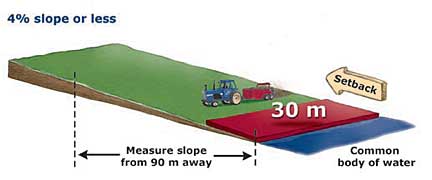

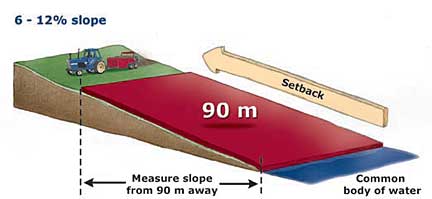
Manure application and short-term storage setbacks on land with 12% slope or greater (on forage, direct-seeded crops, frozen or snow-covered land)
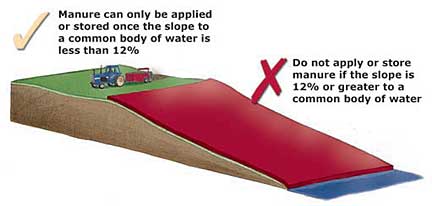
Determining Slope
To determine the average slope, use the shore of the common body of water as the starting point. Measure horizontally 90 metres away and then measure the vertical difference in elevation. The percent (%) slope is calculated by dividing the vertical rise from the shore to the field location by 90 m. The following formula shows the calculation:
The following examples may help as a guide in determining the slope of the land:
- 4% slope is equal to a 3.6 m rise over a 90 m horizontal distance
- 6% slope is equal to a 5.4 m rise over a 90 m horizontal distance
- 12% slope is equal to a 10.8 m rise over a 90 m horizontal distance
The following figure illustrates where the elevations should be measured.
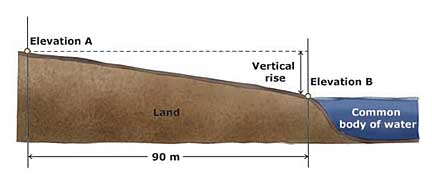
Common Body of Water
The term “common body of water” in the legislation includes the bed and shore of a water body that is shared by (common to) more than one landowner. The following table summarizes what is and is not considered a common body of water.
| A common body of water includes | A common body of water DOES NOT include |
The bed and shore of the following
• river, stream, creek
• reservoir, lake, marsh, slough | A reservoir, lake, marsh or slough that is completely surrounded by private land controlled by the owner or operator and has no outflow going directly beyond the private land to a drainage canal, reservoir, river, permanent stream or creek, lake or potable water source that is being used for human or livestock consumption. |
The bed and shore of the following:
• irrigation canal
• drainage canal | An irrigation canal or a drainage canal that is completely surrounded by private land controlled by the owner or operator and has no outflow going beyond the private land. |
 | A roadside ditch. |
 | A storm drainage or wastewater system (sewer system). |
For more information, contact:
(Dial 310-0000 to be connected toll-free)
Alberta Agriculture and Forestry
Lethbridge 403-381-5885
Red Deer 403-755-1475
Morinville 780-939-1218
Ag-Info Centre 310-FARM (3276)
Publications 780-427-0391
Natural Resources Conservation Board
Lethbridge 403-381-5166
Red Deer 403-340-5241
Morinville 780-939-1212
Fairview 780-835-7111
Response Line 1-866-383-6722
DISCLAIMER: This document is not intended as legal advice, but as an interpretive document to the Agriculture Operation Practices Act and Regulations.
Source: Agdex 096-5. Revised Sept 2015. |
|